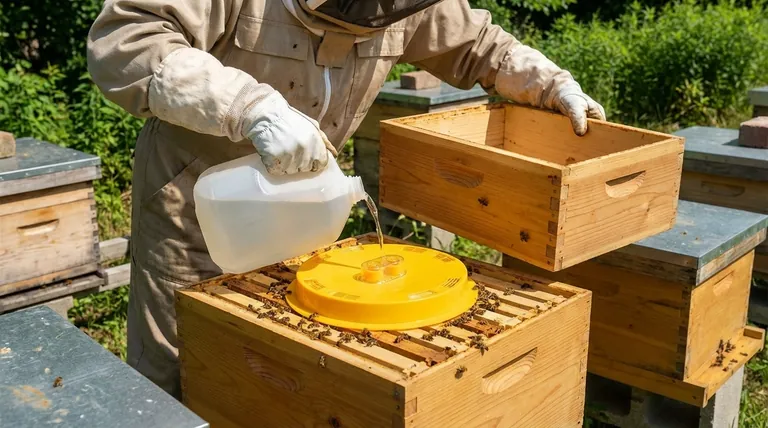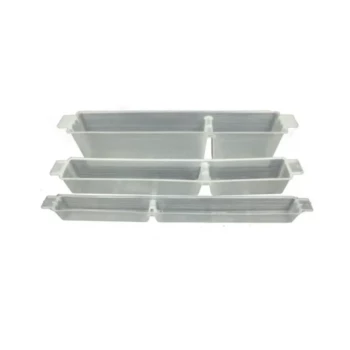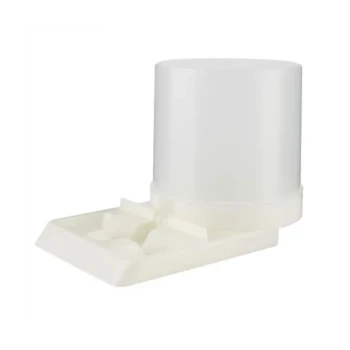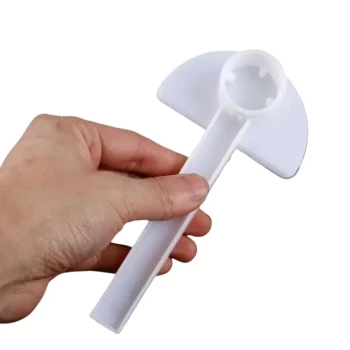To use a round hive top feeder, it is placed directly on top of the uppermost frames or inner cover of your colony. An empty hive box (often called a super or a spacer rim) is then set around the feeder to enclose it, and the outer cover is placed on top of this empty box to seal the hive.
The core challenge of feeding bees is providing nourishment without exposing the colony to risks like robbing by other bees or chilling the brood. The round hive top feeder solves this by containing the feed entirely within the insulated, protected space of the hive itself.

The Mechanics of a Hive Top Feeder Setup
Correctly setting up a hive top feeder is a simple process that ensures the bees can access the food safely and efficiently while protecting them from the outside environment.
Step 1: Access the Top of the Colony
First, remove the hive's outer cover and inner cover. This exposes the top bars of the frames in the uppermost box where the bees are clustered.
Step 2: Position the Feeder
Place the round feeder directly on top of the frames. Most beekeepers will place it over the central cluster of bees. If you use an inner cover with a central hole, you can place the feeder on the inner cover, aligned with the hole, which gives the bees a dedicated access point.
Step 3: Enclose the Feeder
Place an empty hive body (either a deep or a medium super) on top of the brood box, creating a protective wall or "spacer rim" around the feeder. This is the most critical step for containing the feeder and insulating the space.
Step 4: Fill and Secure the Hive
Fill the feeder with your desired sugar water solution. Finally, place the outer cover back on top of the empty super. This creates a self-contained feeding station within the hive, completely sealed from the outside.
Why This Method is Effective
Using an internal feeder like this is a deliberate choice made by beekeepers to manage specific risks and provide targeted support for the colony.
Minimizing Robbing
External feeders, like entrance feeders, can create a "feeding frenzy," attracting bees from other hives. This can lead to robbing, where stronger colonies attack and steal the resources of the weaker hive you are trying to help. By placing the food source inside, it remains hidden from outsiders.
Protection from the Elements
The sugar water is kept clean from rain, leaves, and other debris. It also stays at a more stable temperature, preventing it from spoiling quickly in the heat or freezing in a sudden cold snap.
Easy Access for the Colony
The feeder is located directly above the bee cluster. This allows the bees to access the food with minimal travel, conserving energy, which is especially important for weaker colonies or during cooler weather. The central cone or cup design allows bees to climb up to the syrup while preventing most of them from falling in and drowning.
Understanding the Trade-offs and Risks
While effective, this method is not without its drawbacks. Understanding them allows you to make an informed decision and mitigate potential problems.
The Risk of Drowning
Although designed to be safe, some bees can still drown in the syrup. Many beekeepers add "floats" like corks, small twigs, or pieces of hardware cloth to the syrup reservoir to give the bees more places to land and prevent drowning.
The Need to Open the Hive
The primary trade-off is that you must open the hive to check and refill the feeder. This disturbs the colony and releases heat and hive odors. In very cold weather, this disturbance can be stressful for the bees.
Potential to Chill the Brood
Adding a large, empty super on top of the colony increases the interior space the bees must keep warm. For a small or weak colony, this excess space can make it difficult to maintain the proper temperature for the brood nest, potentially slowing colony development.
Making the Right Choice for Your Goal
Your feeding strategy should align with your specific objective for the colony.
- If your primary focus is stimulating spring buildup: Use a round hive top feeder with a 1:1 sugar-to-water ratio to mimic a natural nectar flow and encourage the queen to lay eggs.
- If your primary focus is providing emergency winter food: Use this method with a thick 2:1 sugar-to-water ratio, as you can deliver a large volume of dense calories with minimal disturbance.
- If your primary focus is maximum convenience and minimal disturbance: You might consider an external Boardman (entrance) feeder, but you must be extremely vigilant about the high risk of initiating robbing.
By understanding how a hive top feeder works within the hive's ecosystem, you can effectively support your colony's health and growth.
Summary Table:
| Feeder Type | Placement | Key Benefit | Key Consideration |
|---|---|---|---|
| Round Hive Top Feeder | On top of frames, enclosed by an empty super | Minimizes robbing and protects from weather | Can chill brood in weak colonies; risk of drowning |
Need reliable feeding equipment for your apiary? HONESTBEE supplies commercial beekeepers and distributors with durable, well-designed hive top feeders and other essential beekeeping supplies through our wholesale-focused operations. Ensure your colonies are fed effectively and safely—contact our experts today to discuss your needs and place an order!
Visual Guide

Related Products
- Professional Hive Top Bee Feeder for Beekeeping
- HONESTBEE Round Hive Top Bee Feeder for Syrup
- HONESTBEE Professional Hive Top Bee Feeder Feeding Solution
- In-Hive Dual Compartment Frame Bee Feeder for Targeted Colony Nutrition
- Boardman Entrance Bee Feeder Durable Galvanized Steel and Wood Construction for Beekeeping
People Also Ask
- What is a top feeder for bees? Maximize Colony Health with Efficient Feeding
- How is the plywood floor fitted into the hive-top feeder? Ensure Longevity with a Floating Floor Design
- What are the features of top feeders for bees? Maximize Hive Health with Safe, High-Capacity Feeding
- What are the advantages of using top feeders for bees? Maximize Feeding Efficiency & Colony Safety
- What types of hive boxes is the round hive top feeder compatible with? Universal Fit for 8 & 10-Frame Langstroth Hives



















